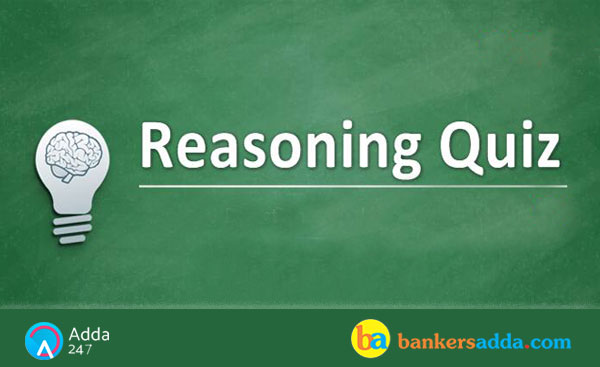Dear Aspirants,

Reasoning Ability is an onerous section. With the increasing complexity of questions, it becomes hard for one to give it the cold shoulder. The only way to make the grade in this particular section in the forthcoming banking exams like IBPS RRB is to practice continuously with all your heart and soul. And, to let you practice with the best of the latest pattern questions, here is the Adda247 Reasoning Quiz based on the study plan and the exact same pattern of questions that are being asked in the exams.
Directions (1-5): Study the set of numbers given below and answer the questions which follow:
867 758 964 683 968
Q1. Which of the following numbers will be obtained if the second digit of the lowest number is subtracted from the first digit of the largest number after subtracting one from each digit of each of the numbers?
(a) 1
(b) 2
(c) 3
(d) 4
(e) 0
Q2. If in each number, the first and the last digits are interchanged, then which of the following will be the third highest number?
(a) 867
(b) 758
(c) 964
(d) 683
(e) 968
Q3. If in each number, the second and the first digits are interchanged, then which will be the highest number?
(a) 867
(b) 758
(c) 964
(d) 683
(e) 968
Q4. If one is subtracted from the first digit of each of the numbers and then the first and the third digits are interchanged, then which of the following will be the lowest?
(a) 867
(b) 758
(c) 964
(d) 683
(e) 968
Q5. If in each number, all the three digits are arranged in the descending order, then which of the following will be the third lowest number?
(a) 867
(b) 758
(c) 964
(d) 683
(e) 968
Direction (6-10): Study the following arrangement carefully and answer the questions given below:
8 6 3 5 1 4 9 4 7 3 2 1 3 9 1 8 1 2 5 7 2 5 9 6 4 2 5 2 8 5 2 6 4
Q6. How many 3s are there in the above arrangement, each of which is immediately preceded by a digit which has a numerical value of more than five?
(a) None
(b) One
(c) Two
(d) Three
(e) More than three
Q7. Which of the following is seventh to the right of the twentieth from the left end of the above arrangement?
(a) 8
(b) 5
(c) 2
(d) 4
(e) 1
Q8. If all the odd digits are deleted (dropped) from the above arrangements, then which of the following will be ninth from the right end of the arrangement?
(a) 1
(b) 8
(c) 6
(d) 4
(e) 2
Q9. How many such 1s are there in the above arrangement each of which is immediately preceded by an odd digit and immediately followed by an even digit?
(a) None
(b) One
(c) Two
(d) Three
(e) More than three
Q10. How many such 3s are there in the above arrangement, each of which is immediately preceded by a perfect cube?
(a) None
(b) One
(c) Two
(d) Three
(e) More than three
Directions (11-15): These questions are based on the following six numbers.
777 878 998 774 989 477
Q11. If two digits numbers are formed by taking the 2nd and 3rd digits respectively of each of these numbers and then the two digits of each of these two digit numbers are interchanged, then which number from the given numbers will be the second highest number in the revised form?
(a) 777
(b) 878
(c) 774
(d) 989
(e) 998
Q12. If all digits are arranged in the ascending order within each number, then how many numbers are less than 500?
(a) Four
(b) Three
(c) One
(d) Two
(e) None of these
Q13. If the resultant of every number is calculated by adding all the digits of each of the numbers, then how many numbers will have resultant which is a perfect cube?
(a) 777
(b) 878
(c) 998
(d) 989
(e) None
Q14. If one is subtracted from the first digit of each of the given numbers and then each digit is arranged in descending order within each number, then which of the following number is third smallest?
(a) 777
(b) 878
(c) 998
(d) 989
(e) 774
Q15. If one is subtracted from middle digit in each given numbers and then all the digits in each number is arranged in ascending order then which of the following number is second highest?
(a) 777
(b) 878
(c) 998
(d) 989
(e) 774




 The Hindu Review October 2022: Download ...
The Hindu Review October 2022: Download ...
 Bank Holidays in March 2025, Monthly Lis...
Bank Holidays in March 2025, Monthly Lis...
 SBI Clerk Prelims Admit Card 2025 Out, D...
SBI Clerk Prelims Admit Card 2025 Out, D...




